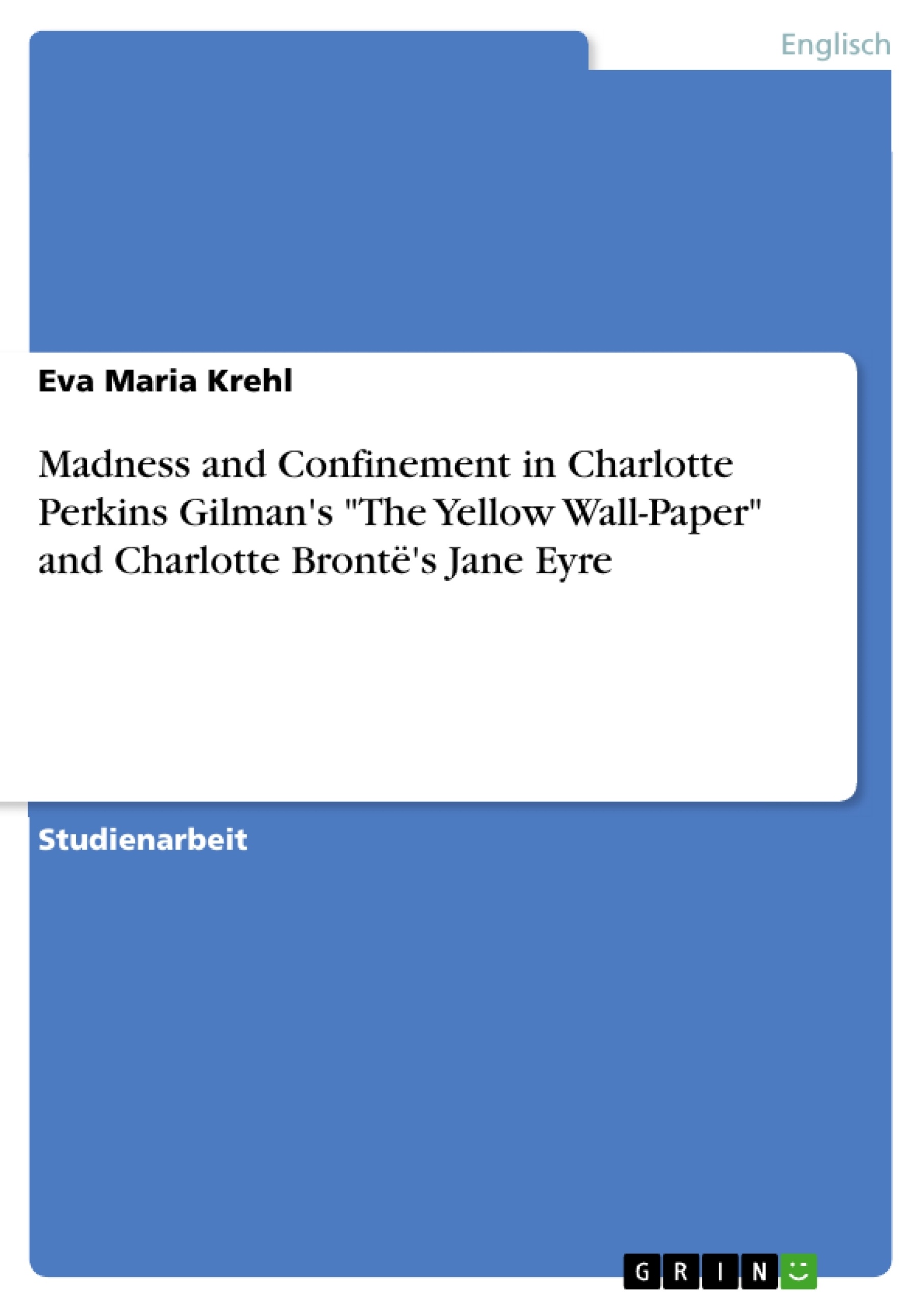A reader of nineteenth century literature by women is bound to encounter a striking coherence of theme and imagery throughout all genres. One of the recurring themes is that of madness and confinement. The often cited “Mad Woman in the Attic,” who is locked away by male authority, appears as a central figure both in Charlotte Perkins Gilman’s short story “The Yellow Wall-Paper,” written in 1890, and Charlotte Brontë’s famous novel Jane Eyre,which was published in 1847. This essay will seek to explore similarities between the two works in respect to their description of madness as an escape from repressive social structures. The mad woman will be discussed as representing a rebellious double to the submissive heroine, who appears to be fragmented and confined by Victorian conventions of propriety. Emphasis will be laid as well on the medical treatment of mental illnesses that both texts deal with. It will be shown that gender-biased medical judgments made by men in both works actually have their origin in subconscious male anxieties.
Inhaltsverzeichnis
- Introduction
- Madness and Confinement in Charlotte Perkins Gilman's "The Yellow Wall-Paper" and Charlotte Brontë's Jane Eyre
- The Role of the Mad Woman
- The Angel in the House: Confined Victorian Women
- The Monster in the House: Gender-Biased Treatment of Mental Illness and Male Anxieties
- Triumph versus Defeat
- Conclusion
- The Role of the Mad Woman
Zielsetzung und Themenschwerpunkte
Diese Arbeit untersucht die Parallelen zwischen Charlotte Perkins Gilmans Kurzgeschichte "The Yellow Wall-Paper" und Charlotte Brontës Roman "Jane Eyre" hinsichtlich des Themas Wahnsinn und Gefangenschaft. Ziel ist es, die Darstellung von Wahnsinn als Flucht vor repressiven sozialen Strukturen zu beleuchten und die geschlechtsspezifische medizinische Behandlung von psychischen Erkrankungen im Kontext männlicher Ängste zu analysieren.
- Die Rolle der Verrückten Frau als rebellisches Gegenstück zur unterwürfigen Heldin
- Die Auswirkungen viktorianischer Konventionen und sozialer Restriktionen auf Frauen
- Geschlechtsspezifische Voreingenommenheit in der medizinischen Beurteilung psychischer Erkrankungen
- Die Darstellung männlicher Ängste im Kontext der weiblichen psychischen Erkrankung
- Flucht in den Wahnsinn als Akt der Rebellion
Zusammenfassung der Kapitel
Introduction: Die Einleitung führt in das Thema Wahnsinn und Gefangenschaft in der Literatur des 19. Jahrhunderts ein und stellt die beiden zu untersuchenden Werke, "The Yellow Wall-Paper" und "Jane Eyre", vor. Sie beschreibt die "verrückte Frau auf dem Dachboden" als zentrale Figur und kündigt die Untersuchung der Ähnlichkeiten in der Darstellung von Wahnsinn als Flucht vor repressiven sozialen Strukturen an. Die Bedeutung geschlechtsspezifischer medizinischer Urteile und deren Verknüpfung mit unbewussten männlichen Ängsten wird ebenfalls hervorgehoben.
Madness and Confinement in Charlotte Perkins Gilman's "The Yellow Wall-Paper" and Charlotte Brontë's Jane Eyre: Dieses Kapitel analysiert die Rolle der verrückten Frau in beiden Werken. Es untersucht die Einschränkungen viktorianischer Frauen, die als "Engel im Haus" idealisiert, aber rechtlos und auf den privaten Bereich beschränkt waren. Die Erzählerin in "The Yellow Wall-Paper" rebelliert heimlich durch das Führen eines Tagebuchs und den Ungehorsam gegenüber ihrem Ehemann. Ihre zunehmende Obsession mit der Tapete symbolisiert ihre repressive Umgebung, und ihr finaler Ausbruch in Wahnsinn wird als Akt der Flucht interpretiert. Der Text untersucht die geschlechtsspezifische Voreingenommenheit in der medizinischen Beurteilung und die zugrundeliegenden männlichen Ängste.
Schlüsselwörter
Wahnsinn, Gefangenschaft, viktorianische Gesellschaft, Geschlechterrollen, "The Yellow Wall-Paper", "Jane Eyre", geschlechtsspezifische Medizin, männliche Ängste, Rebellion, Repression, soziale Strukturen.
Häufig gestellte Fragen zu: Wahnsinn und Gefangenschaft in "The Yellow Wall-Paper" und "Jane Eyre"
Was ist das Thema dieser Arbeit?
Diese Arbeit analysiert die Parallelen zwischen Charlotte Perkins Gilmans Kurzgeschichte "The Yellow Wall-Paper" und Charlotte Brontës Roman "Jane Eyre" im Hinblick auf die Themen Wahnsinn und Gefangenschaft. Der Fokus liegt auf der Darstellung von Wahnsinn als Flucht vor repressiven sozialen Strukturen und der geschlechtsspezifischen Behandlung von psychischen Erkrankungen im Kontext männlicher Ängste.
Welche Werke werden untersucht?
Die Arbeit konzentriert sich auf zwei Werke: Charlotte Perkins Gilmans Kurzgeschichte "The Yellow Wall-Paper" und Charlotte Brontës Roman "Jane Eyre". Beide Texte werden daraufhin untersucht, wie sie Wahnsinn und die Einschränkungen von Frauen in der viktorianischen Gesellschaft darstellen.
Welche zentralen Fragen werden behandelt?
Zentrale Fragen sind: Wie wird Wahnsinn als Ausdruck von Rebellion gegen repressive soziale Strukturen dargestellt? Wie beeinflussten viktorianische Konventionen und soziale Restriktionen die Frauen? Welche geschlechtsspezifische Voreingenommenheit zeigt sich in der medizinischen Beurteilung psychischer Erkrankungen? Welche Rolle spielen männliche Ängste in diesem Kontext? Und schließlich: Wie wird die "verrückte Frau" als rebellisches Gegenstück zur unterwürfigen Heldin dargestellt?
Welche Rolle spielt die "verrückte Frau"?
Die "verrückte Frau" fungiert als zentrales Element der Analyse. Die Arbeit untersucht sie als rebellisches Gegenstück zur unterwürfigen, idealisierten Frau der viktorianischen Gesellschaft ("Engel im Haus"). Ihr Wahnsinn wird als Akt der Rebellion und Flucht vor den repressiven sozialen Strukturen interpretiert.
Wie werden die Kapitel aufgebaut?
Die Arbeit beginnt mit einer Einleitung, die das Thema einführt und die beiden untersuchten Werke vorstellt. Das Hauptkapitel analysiert die Rolle der "verrückten Frau" in "The Yellow Wall-Paper" und "Jane Eyre", beleuchtet die viktorianischen Einschränkungen für Frauen und die geschlechtsspezifische Voreingenommenheit in der medizinischen Behandlung. Die Arbeit schließt mit einer Zusammenfassung der Ergebnisse und Schlüsselbegriffen.
Welche Schlüsselwörter beschreiben die Arbeit am besten?
Schlüsselwörter sind: Wahnsinn, Gefangenschaft, viktorianische Gesellschaft, Geschlechterrollen, "The Yellow Wall-Paper", "Jane Eyre", geschlechtsspezifische Medizin, männliche Ängste, Rebellion, Repression, soziale Strukturen.
Welches ist das übergeordnete Ziel der Arbeit?
Das übergeordnete Ziel ist es, die Darstellung von Wahnsinn und Gefangenschaft in den beiden ausgewählten Werken zu analysieren und die geschlechtsspezifischen Aspekte der medizinischen Behandlung psychischer Erkrankungen im viktorianischen Kontext zu beleuchten.
- Citar trabajo
- Eva Maria Krehl (Autor), 2005, Madness and Confinement in Charlotte Perkins Gilman's "The Yellow Wall-Paper" and Charlotte Brontë's Jane Eyre , Múnich, GRIN Verlag, https://www.grin.com/document/60984



